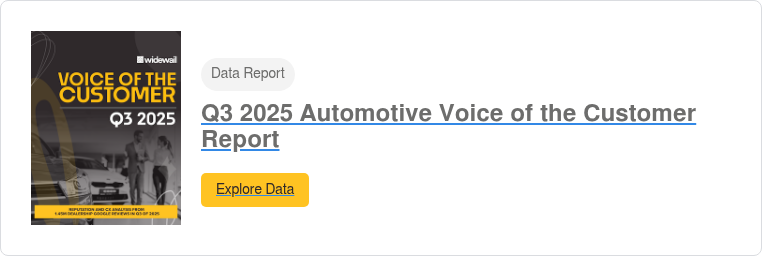Having a great conversation with your customers is just like having a conversation with anyone else: it’s give and take.
Typically, customers write Google reviews as a reaction to direct interaction with your business, which means this particular conversation starts with your performance. Your product or service speaks first.
But when your customers respond to their experiences, what’s your next step? Should you engage in further discourse? Or perhaps you’ll make a measured change to your operations. Strong reputation management requires the willingness and ability to do both:
- Manage the brand in the moment, based on individuals, on the frontend, and
- Direct the future of the brand, based on aggregate information, on the backend.
This post focuses on #2: How you can use Google reviews to help solve problems and identify opportunities to make changes on the backend — changes whose effect will be reflected in your future reviews.
So, where do you start?
We suggest beginning with an open mind.
How to Use Google Reviews to Identify Operational Opportunities
With the mindset that reviews — even negative ones — can present opportunities for your business, you can start forming a plan for how your business will use the information your customers give you.
But wait! First, you need the information. It’s hard to have a conversation without it. That’s why your strategy for implementing operational improvement based on feedback has to begin with…well, generating honest feedback.
Read our tips about how to generate more reviews here.
While you go about executing a review generation strategy, you’re likely to encounter at least some unsolicited feedback about your business, as well as new and unexpected information. That’s just one of several reasons to begin your evaluation/response process through collecting and categorizing the information you receive.
How to Collect and Divide Google Review Feedback
There are numerous ways to aggregate and categorize the feedback you receive from your customers. There are negative reviews, positive reviews, implicit information and explicit information, individual reviews and groups of reviews.
Then there are marketing-solicited videos and customer service conversations, as well as many other channels from which you can collect feedback.
Assuming you are using your Google Business Profile to aggregate reviews already, treat these other feedback sources as part of this effort as well; your Google reviews don’t live in a vacuum.
Imagine you had sourced a testimonial video that perfectly echoed something a different customer had shared in a Google review. That’s important to know! Now you’ve seen that your business has given the same impression to two people.
Once you’ve identified all of your channels, aggregate your reviews from these channels in a central location, and begin the categorization: label them by format (video? Google review? Etc.); by date; and by customer type, product type or service type, if relevant. This categorization and labeling will help you sort your feedback for evaluation.
You’ve generated your reviews, you’ve aggregated your reviews. You’ve even categorized them neatly. Now what? The next part of the cycle kicks off: discovering meaning.
What Can You Learn?
Because the value of feedback evaluation is in what you learn, we have to start by considering the extreme breadth of possibilities. You could learn anything — literally anything — from Google reviews. You might learn that Jenna F. hates when her service person shows up five minutes early. You might learn that all of your customers struggle with your delivery windows. You could learn that your product has shown up damaged more than three times, at least. Or that no one who has ever left a review had a good experience with your front office staff. Every single review, and every group of reviews, can give you new insight.
But what matters? How do you identify what to tackle first?
There are two distinct ways to approach evaluation.
- Decide what you want to learn and begin searching for relevant information, e.g. “I need to know if we’re delivering on time.”
- View each review conversation and identify both individual experiences and trends, e.g., “Wow, three people have said we aren’t delivering on time.”
Both are important in order to truly grasp trends, and the first can be a way to verify what you learn from the second. But the latter lets you identify the challenges you don’t already know you have, and find the opportunity for improvement hidden in the feedback.

If You Know What You’re Looking For
Based on how much time and expense you can devote to operational improvements (vs. simply operating business as usual), you may choose that a clear goal for improvement is the place to begin. You need direction because your investment is too great to try to identify every opportunity on the table, or because you’ve identified an opportunity already. That’s fine!
Go into the process with your goal clearly outlined, e.g. “I want every employee to deliver five-star service.” Then dial in: “How many customers have said they’ve only received three-star service? What do those reviews have in common?” (Here’s where your previous aggregation and sorting process will be handy. If you’re storing your reviews in a spreadsheet or any external system, column sorts or a quick ctrl+f can do wonders.)
From there, begin to outline the trends in this area and connect them (theoretically) to the backend of your business. Let’s say all of the three-star reviews note that the customers came in on a certain day, and you were out of a product. You might identify there’s an issue in your ordering, and it’s a simple fix: You need to order some more of that product. Start to implement the change.
You now moved from learning something you wanted to know (what’s holding my customers back from five-star reviews?) to identifying a new opportunity. It can be even more straightforward to identify those unexpected opportunities when you don’t really know what you’re looking for — but it can also be more overwhelming.
If You Don’t Know What You’re Looking For
When you don’t know what you’re looking for, every sentence can reveal an opportunity (or a problem). You don’t know what changes you want to make, so you have to decide how to identify what’s important.
Blanket rule: Anything involving customer safety and health will always come first. Immediate response, sometimes operational, is required; if sandwiches purchased at your business made customers fall ill, you need to contact your supplier.
Outside of that: Make a list of all the wins and losses, triumphs and issues, you identify as you evaluate your feedback. Keep a record so you can track how these items trend later. As you do this, connect these learnings to ways to improve your business — in other words, create the meaning.
You’ll begin to see quick wins emerge, and you’ll begin to find where larger investments are required, too. A quick win might look like solving an individual customer’s problem by ordering a new product for their next visit. A long-term change might look like upgrading your product lines to support an increase in interest, which you noticed declined over time. Or you might have noticed an uptick in positive reviews about diversity in your product line, so you begin adding more products.
Next, you’ll begin to make changes. How you approach this is truly up to you. You decide your threshold for what constitutes a trend, and you decide what seems relevant and valuable enough to change, and how quickly — and you decide how much you can invest in that change. Priorities emerge.
Let’s review. You’ve collected your feedback, categorized it, and you have begun to sort through it to identify possible operational improvement opportunities. You’ve connected what you’ve learned to potential ways to improve those elements of the business. And you’ve determined your priorities and are making changes. What happens after that?
The conversation continues.
Learning Over Time: Open Conversation
For your business to continue to evolve and learn, you need to continue to evaluate customer feedback. Decide on a cadence for reviewing information and stick to it. Over time, more trends will emerge and you’ll see how people are responding to the changes you’ve already implemented — that’s one way for you to evaluate their success.
And so on. You’ll implement further changes. Your customers will continue to respond. Yes, your product or service “speaks first”, but at any given point in time, with any given customer, your delivery should be a reflection of what you’ve already learned from your previous customers.
In that way, reviews are an ever-evolving conversation that drive the active nature of reputation management — nothing is static. We think of that as a huge opportunity for any business to just keep getting better.










U3GM Blog Post Comments